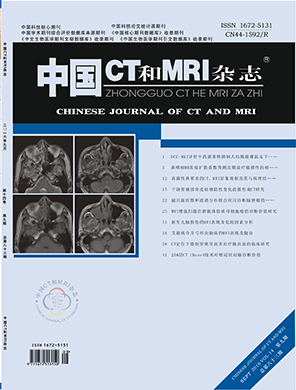摘要
目的 探讨新生儿脑损伤MRI表 现及危险因素。方法 以本院2013年2 月-2015年2月收治的40例新生儿脑损伤 患儿为研究对象,均接受颅脑CT、MRI检 查,观察MRI影像学表现,将其病灶异常 检出率与CT检查对比;同时选择50例同期 低血糖但无脑损伤新生儿为对照组,比较 两组胎龄、分娩方式、血糖水平等情况, 多因素Logistic回归分析新生儿脑损伤发 生危险因素。结果 MRI发现脑损伤37例 (92.50%)显著高于CT检查的30例(75.00%) (P<0.05)。MRI发现37例患者中顶叶10 例,枕叶12例,顶枕叶15例;均表现为 DWI高信号、T1WI低信号,T2WI以高信号 为主。Logistic多因素回归分析发现惊 厥、低血糖水平(0.5-1.4 mmol/L)、低血 糖持续时间>24 h及脑电图异常为新生儿 脑损伤独立危险因素。结论 MRI对新生儿 脑损伤诊断检出率高,新生儿脑损伤危险 因素包括惊厥、低血糖持续时间大>24 h、脑电图异常等,两者对疾病干预均有 一定的指导作用。
Objective To investigate the MRI findings and risk factors of neonatal brain injury. Methods 40 cases of neonates with brain injury who were treated in our hospital between February 2013 and February 2015 were selected as study subjects. All underwent brain CT and MRI examination. The MRI manifestations were observed.The detection rate of abnormal lesions was compared with that of CT, at the same time, 50 cases of neonates with hypoglycemia and without brain injury were selected as control group. The gestational age, delivery mode and blood glucose level were compared between the two groups. Multivariate Logistic regression analysis was performed to analyze the risk factors of neonatal brain injury. Results MRI found that there were abnormalities (brain injury) in 37 cases (92.50%) which were significantly higher than those detected by CT (30 cases and accounts for 75.00%) (P<0.05). MRI found that in 37 cases, there were 10 cases with lesions in the parietal lobe, 12 cases in occipital lobe and 15 cases in parietal-occipital lobe lobe, all manifested as high signal on DWI, low signal on T1WI and high signal on T2WI. Multivariate Logistic regression analysis showed that seizure, hypoglycemia level (0.5-1.4 mmol/L), duration of hypoglycemia > 24h and abnormal EEG were the independent risk factors of neonatal brain injury. Conclusion MRI in the diagnosis of neonatal brain injury has a high detection rate. The risk factors of neonatal brain injury include seizure, duration of hypoglycemia > 24h and EEG abnormalities, etc. Both of the two diagnostic methods have certain guiding effect in intervention of the disease
【关键词】新生儿脑损伤;MRI;危险因 素;低血糖
【中图分类号】R445;R722
【文献标识码】A
【DOI】 10.3969/j.issn.1672- 5131.2016.09.010
前言
新生儿脑损伤病因复杂,其中低血糖脑损伤比较常见。据统计, 新生儿低血糖发生几率可达5%[1],会损害神经系统,若低血糖持续时 间太长或反复出现可能影响脑部功能,严重时遗留后遗症,是导致 新生儿死亡的高危因素之一[2]。由于新生儿低血糖脑病早期症状不明 显,加上其发病机制复杂,目前尚无统一诊断标准,为此采取何种方 式尽早诊断、提高新生儿低血糖脑损伤的诊断率成为当下研究的重难 点。有研究表明相比CT,MRI对低血糖脑损伤诊断敏感度、特异度高, 特别是扩散加权成像技术(DWI)[3-4]。本研究一方面观察新生儿脑损伤 MRI表现,以其他综合检查为金标准,探讨MRI诊断价值,另一方面分 析新生儿低血糖脑损伤发生危险因素,为疾病临床诊断、治疗提供参 考。报告如下。
中国CT和MRI杂志
第14卷, 第 9 期
2016年09月

相关文章